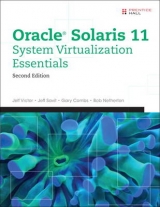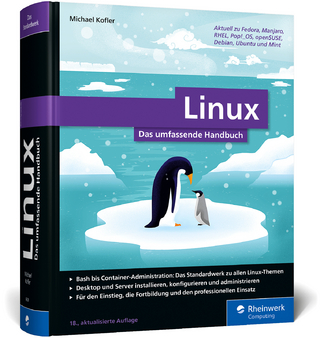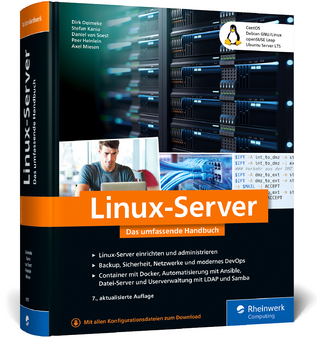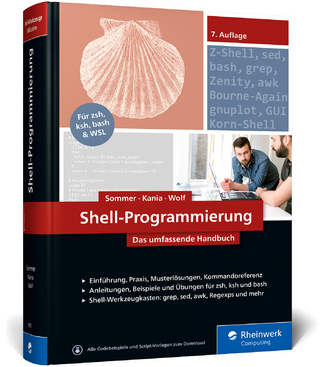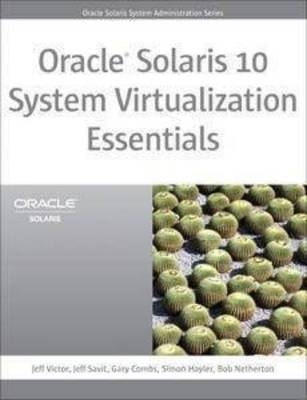
Oracle Solaris 10 System Virtualization Essentials
Prentice Hall (Verlag)
978-0-13-708188-2 (ISBN)
- Titel erscheint in neuer Auflage
- Artikel merken
Oracle® Solaris™ 10 System Virtualization Essentials provides an accessible introduction to computer virtualization, specifically the system virtualization technologies that use the Oracle Solaris or OpenSolaris operating systems. This accessible guide covers the key concepts system administrators need to understand and explains how to
Use Dynamic Domains to maximize workload isolation on Sun SPARC systems
Use Oracle VM Server for SPARC to deploy different Oracle Solaris 10 and OpenSolaris environments on SPARC CMT (chip multithreading) systems
Use Oracle VM Server for x86 or xVM hypervisor to deploy a server with heterogeneous operating systems
Use Oracle VM VirtualBox to develop and test software in heterogeneous environments
Use Oracle Solaris Containers to maximize efficiency and scalability of workloads
Use Oracle Solaris Containers to migrate Solaris 8 and Solaris 9 workloads to new hardware systems
Mix virtualization technologies to maximize workload density
Starting with a discussion of system virtualization in general terms—the needs of consolidation, the benefits of virtualization, and a description of the most common types of computer virtualization—this book also covers many of the concepts, features, and methods shared by many implementations of system virtualization.
Oracle’s computer virtualization technologies that are directly related to the Oracle Solaris OS are described in detail along with a discussion of the factors that should be considered when choosing a virtualization technology. Finally, several examples of these technologies and an overview of virtualization management software are provided, as well as a history of virtualization.
Jeff Victor is the principal author of Oracle® Solaris 10 System Virtualization Essentials and a principal sales consultant at Oracle Corporation. Prior to joining Oracle, Jeff was a principal field technologist for Sun Microsystems. He is an OpenSolaris Zones Community Leader, the creator of the zonestat open-source program, and a regular author, contributor, and speaker at corporate and industry events. His blog can be found at http://blogs.sun.com/JeffV. Jeff received a bachelor of science degree in computer science from Rensselaer Polytechnic Institute. In his spare time, he builds and launches high-power rockets. Jeff lives in New York with his wife and daughter. Jeff Savit has more than 25 years of experience in operating systems, virtualization, and performance on multiple platforms, and is a principal sales consultant at Oracle Corporation specializing in these areas. He was previously a principal field technologist at Sun Microsystems with a similar focus. Before joining Sun, Jeff was a vice president at Merrill Lynch, where he had roles in development, systems management, market data, and web applications. He also managed a department responsible for the firm’s virtual machine systems, wrote market data portions of Merrill Lynch’s Internet trading applications, and created one of the Internet’s first stock quote websites. Jeff is the author of the Sun Blueprint Energy Efficiency Strategies: Sun Server Virtualization Technology, and the virtualization chapter of the Datacenter Reference Guide Blueprint. Jeff has written or coauthored several books, including Enterprise Java, VM and CMS: Performance and Fine-Tuning, and VM/CMS Concepts and Facilities, and his work has been published in SIGPLAN Notices, a journal of the Association of Computing Machinery. He has a master’s degree in computer science from Cornell University. Gary Combs is a SPARC specialist at Oracle Corporation. He specializes in midrange and high-end SPARC servers, which include the popular M-Series. Gary also covers virtualization technologies that are implemented on these platforms: Dynamic Domains, Logical Domains, and Oracle Solaris Containers. Prior to joining Oracle, Gary was with Sun Microsystems. He has more than 15 years of direct sales support experience as a systems engineer. For the last 10 years, Gary has held marketing positions in product management, product definition, and technical marketing. Simon Hayler is a principal sales consultant for Oracle Corporation. Previously, Simon was a principal field technologist for Sun Microsystems. Simon has a telecommunications engineering background, encompassing the design, configuration, and implementation of multitiered information systems. His role at Sun over the past 12 years has included pre- and post-sales consulting, architectural design and implementation for both high-end commercial and high-performance computing, and, more recently, specialization in virtualization solutions. Bob Netherton is a principal sales consultant at Oracle Corporation specializing in Oracle Solaris, virtualization, open-source software, and Linux interoperability. Prior to joining Oracle, Bob was a principal field technologist for Sun Microsystems, and was one of the architects and content developers of the Solaris Boot Camp and Deep Dive seminar series. In addition, he has developed several best practices guides for Solaris as well as an advanced Solaris training curriculum. Bob is also involved in several OpenSolaris users groups in the American Midwest and Southwest. Bob received a bachelor of science degree in applied mathematics from the University of Missouri, and he is a regular blogger on Solaris, virtualization, and open-source technologies.
Foreword xi Preface xv
Acknowledgments xxi
About the Authors xxiii
Chapter 1: Introduction to Virtualization 1
1.1 Definitions and Motivations 1
1.2 System Virtualization Models 26
1.3 Summary 41
Chapter 2: Hard Partitioning: Dynamic Domains 43
2.1 Partitions 44
2.2 Domain Implementation 44
2.3 Managing Domains 59
2.4 Summary 76
Chapter 3: Oracle VM Server for SPARC 77
3.1 Overview of Logical Domains Features 77
3.2 Logical Domains Implementation 80
3.3 Details of Domain Resources 84
3.4 Installing Logical Domains and Building a Guest Domain 89
3.5 Domain Mobility 104
3.6 Physical to Virtual Conversion 106
3.7 Ease-of-Use Enhancements 108
3.8 Comparison with Oracle Solaris Containers 110
3.9 Summary 110
Chapter 4: Oracle Solaris 10 as an x86 Guest 113
4.1 Overview 114
4.2 Oracle VM Server for x86 116
4.3 xVM Hypervisor 118
4.4 Citrix XenServer 120
4.5 VMware ESX 121
4.6 Microsoft Windows Server 2008 Hyper-V 123
4.7 Red Hat Enterprise Virtualization 125
4.8 Summary 127
Chapter 5: Oracle VM VirtualBox 129
5.1 How Oracle VM VirtualBox Works 131
5.2 Oracle VM VirtualBox Guest Platform 134
5.3 Oracle Solaris as an Oracle VM VirtualBox Host 145
5.4 Oracle Solaris as an Oracle VM VirtualBox Guest 149
5.5 Creating and Managing Oracle VM VirtualBox Guests 151
5.6 Summary 167
Chapter 6: Oracle Solaris Containers 169
6.1 Feature Overview 170
6.2 Feature Details 181
6.3 Solaris 8 Containers and Solaris 9 Containers 219
6.4 Network Virtualization in OpenSolaris 222
6.5 Strengths of Oracle Solaris Containers 225
6.6 Summary 226
Chapter 7: Choosing a Virtualization Technology 227
7.1 Review of Strengths and Limitations 227
7.2 Choosing the Technology: Start with Requirements 235
7.3 Virtualization Decision Tree 236
7.4 Choosing the Technology: Examples 237
7.5 Summary 239
Chapter 8: Applying Virtualization 241
8.1 How to Configure for Dynamic Domains 241
8.2 Consolidating with Oracle VM Server for SPARC (Logical Domains) 254
8.3 Deploying Oracle Solaris 10 with Oracle VM Server for x86 258
8.4 How to Enable xVM Hypervisor Live Migration 268
8.5 Running Microsoft Windows in an Oracle Solaris Container 276
8.6 Consolidating with Oracle Solaris Containers 285
8.7 Security Hardening with Oracle Solaris Containers 290
8.8 Summary 300
Chapter 9: Virtualization Management 301
9.1 VE Life-Cycle Management 303
9.2 Opportunities for Business Agility and Operational Flexibility 306
9.3 Oracle Enterprise Manager Ops Center 315
9.4 Summary 326
Appendix: History of Virtualization and Architectural Evolution 327
Index 345
| Erscheint lt. Verlag | 16.9.2010 |
|---|---|
| Verlagsort | Upper Saddle River |
| Sprache | englisch |
| Maße | 181 x 231 mm |
| Gewicht | 620 g |
| Themenwelt | Informatik ► Betriebssysteme / Server ► Unix / Linux |
| Informatik ► Betriebssysteme / Server ► Virtualisierung | |
| ISBN-10 | 0-13-708188-X / 013708188X |
| ISBN-13 | 978-0-13-708188-2 / 9780137081882 |
| Zustand | Neuware |
| Haben Sie eine Frage zum Produkt? |
aus dem Bereich
